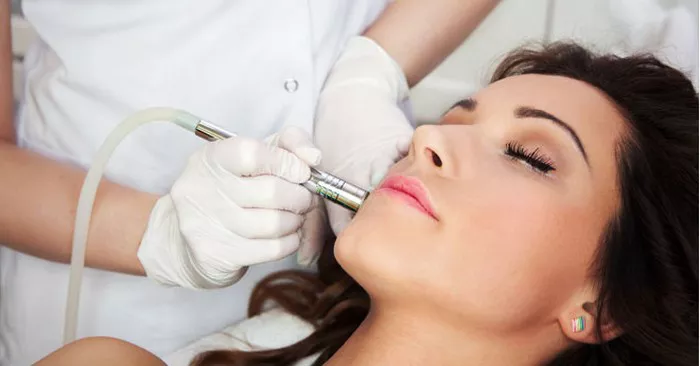Microdermabrasion is a popular non-invasive skincare treatment that has gained widespread popularity for its ability to rejuvenate the skin and improve various skin concerns. This gentle yet effective procedure involves exfoliating the outermost layer of the skin to reveal a smoother, more radiant complexion. In this article, we will explore the benefits of microdermabrasion for the skin, how the treatment works, its potential risks, and what you can expect from this revitalizing skincare procedure.
Understanding Microdermabrasion
Microdermabrasion is a cosmetic procedure designed to improve the texture and appearance of the skin by removing dead skin cells and promoting skin cell turnover. It involves the use of a specialized handheld device that gently exfoliates the skin’s surface, revealing a fresher and more youthful-looking complexion.
During the treatment, the device uses either a stream of tiny crystals or a diamond-tipped wand to abrade the skin. Simultaneously, a vacuum-like mechanism suctions away the exfoliated skin cells, debris, and impurities, leaving the skin smoother and brighter. The procedure is usually painless and requires little to no downtime, making it a convenient option for busy individuals seeking visible skin improvements.
Benefits of Microdermabrasion for the Skin
Exfoliation: The primary benefit of microdermabrasion is its exfoliating effect. By removing dead skin cells from the surface, the treatment promotes the generation of new, healthier skin cells, resulting in a more youthful and vibrant appearance.
Improved Skin Texture: Microdermabrasion addresses concerns such as rough skin texture, fine lines, and mild acne scars, resulting in a smoother and more refined skin texture.
Brighter Complexion: The exfoliation process reveals fresh, undamaged skin underneath, leading to a brighter and more radiant complexion.
Reduced Pore Size: Microdermabrasion can help unclog and minimize the appearance of enlarged pores, contributing to a more even skin tone.
Enhanced Product Absorption: Exfoliating the skin with microdermabrasion improves the skin’s ability to absorb skincare products, allowing for better penetration of serums and moisturizers.
Mild Pigmentation Correction: The treatment may help reduce the appearance of mild hyperpigmentation, sunspots, and age spots, creating a more even skin tone.
Non-Invasive and Quick: Microdermabrasion is a non-invasive procedure that requires no anesthesia and usually takes 30 minutes to an hour to complete, making it a convenient choice for individuals with busy schedules.
Who Can Benefit from Microdermabrasion?
Microdermabrasion is suitable for a wide range of skin types and concerns, including:
Dull and Lackluster Skin: If your skin lacks radiance and appears tired or dull, microdermabrasion can help rejuvenate and revitalize your complexion.
Fine Lines and Wrinkles: Microdermabrasion can soften the appearance of fine lines and wrinkles, particularly those caused by sun damage and aging.
Mild Acne Scarring: For individuals with mild acne scarring or post-inflammatory hyperpigmentation, microdermabrasion can improve skin texture and reduce the visibility of scars.
Enlarged Pores: Microdermabrasion can help unclog and minimize the appearance of enlarged pores, promoting smoother-looking skin.
Uneven Skin Tone and Pigmentation: If you have mild to moderate skin discoloration or sunspots, microdermabrasion may contribute to a more even skin tone.
Congested or Acne-Prone Skin: The exfoliating action of microdermabrasion can help reduce clogged pores and breakouts in individuals with congested or acne-prone skin.
The Microdermabrasion Procedure
The microdermabrasion procedure typically involves the following steps:
Cleansing: The skin is thoroughly cleansed to remove any makeup, oils, or debris.
Exfoliation: The microdermabrasion device is gently applied to the skin to exfoliate the surface and remove dead skin cells.
Suction: The device’s vacuum mechanism suctions away the exfoliated particles and impurities, leaving the skin smoother.
Hydration: After the treatment, a hydrating and soothing moisturizer or serum is applied to nourish the skin.
Post-Treatment Care and Recovery
Following microdermabrasion, the skin may appear slightly pink or feel mildly sensitive, similar to a mild sunburn. These effects typically subside within a few hours to a day. It is essential to avoid sun exposure and wear sunscreen to protect the newly exfoliated skin from UV damage.
For best results, patients may need a series of microdermabrasion sessions spaced a few weeks apart. The exact number of treatments required depends on individual skin concerns and the desired outcome.
Potential Risks and Side Effects
Microdermabrasion is generally safe, but there are some potential risks and side effects, including:
Temporary Redness: The skin may appear slightly red immediately after the treatment, but this should subside quickly.
Sensitivity: The skin may feel mildly sensitive or tight for a short period after the procedure.
Sun Sensitivity: The exfoliated skin may be more susceptible to sunburn, so it is essential to apply sunscreen and avoid direct sunlight.
Rare Complications: While uncommon, there is a slight risk of infection, scarring, or changes in skin pigmentation.
Conclusion
Microdermabrasion is a highly effective and non-invasive procedure that offers numerous benefits for the skin. From exfoliating the skin and improving texture to promoting a brighter and more even complexion, microdermabrasion can address various skin concerns and enhance the overall appearance. The procedure is safe for most skin types and requires little to no downtime, making it a convenient option for individuals seeking a quick and noticeable skin refreshment. However, it is essential to consult with a qualified skincare professional or dermatologist to determine if microdermabrasion is suitable for your specific skin needs and to ensure optimal results from this revitalizing skincare treatment.

